
Laravel is a simple and elegant PHP Web development framework (PHP Web Framework). Next, through this article, I will share with you the "standard" development of SMS verification code sending function in Laravel. Friends who need it can refer to it
Introduction to Laravel
Laravel is a simple and elegant PHP Web development framework (PHP Web Framework). It can free you from messy codes like noodles; it can help you build a perfect network APP, and every line of code can be concise and expressive.
Laravel already has an advanced PHP ActiveRecord implementation -- Eloquent ORM. It can easily apply "constraints" to both sides of the relationship, so that you have complete control over the data and enjoy all the conveniences of ActiveRecord. Eloquent natively supports all methods of the query builder (query-builder) in Fluent.
"Standard" development of SMS verification code sending function in LaravelRequirement scenarios
Send a "verification code" or "message notification" to your mobile phone or email.
Complete
First of all, the specification in Laravel is to use Laravel's "Message Notification", here based on the scenario is "Verification Code". This requirement is used by almost all software systems.
Create notification scene
The first step is to use php artisan make:notification to create a notification class. After the creation is successful, three notification classes already exist by default. There are three methods via, toMail and toArray. Because the verification code is sent, this control class is named VerificationCode.
Then create a verification code data model and data table migration. You can use php artisan make:model \"VerificationCode\" -m to quickly create the data model and migration directly.
ThinkSNS migration is as follows:
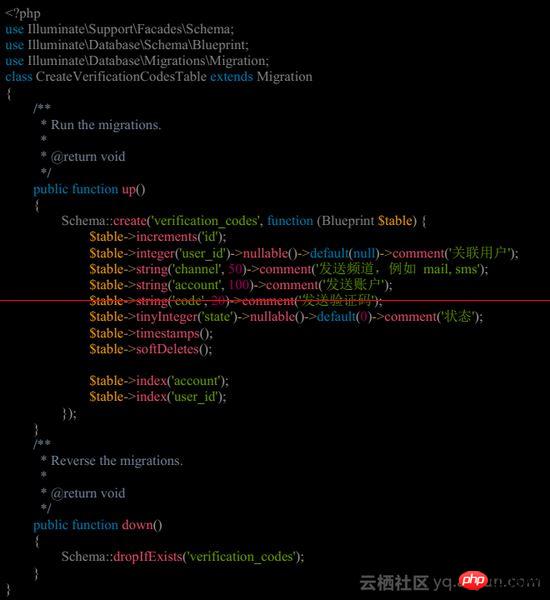
#The second step is to open the data model class and add the Illuminate\Notifications\Notifiable trait in it:
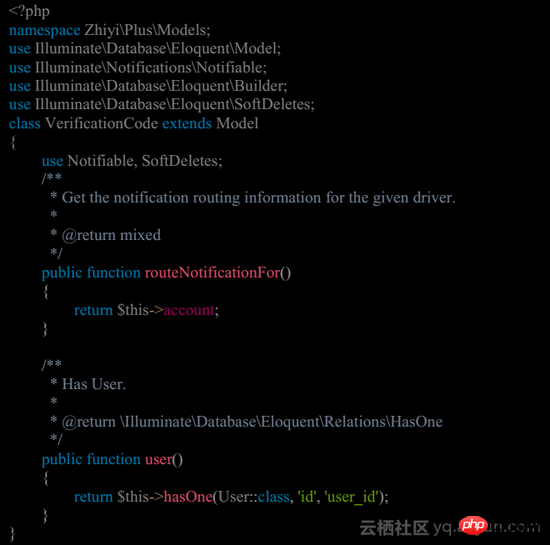
From the code, you can see that we have also added "soft deletion". Because the verification code is sent based on the mobile phone number or email address, there is no need for other built-in tricks or tricks. Recorded in the "Message Notification Data Table", so in the routeNotificationFor method we choose to directly return the account (mobile phone number or email) that needs to be sent.
Join factory mode, send quickly
Open database/factories/ModelFactory.php and add a factory definition about the notification data model:
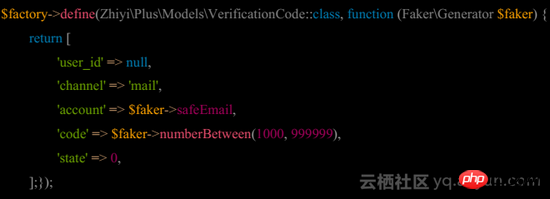
In this way, we can quickly create verification codes and send notifications through the factory(\Zhiyi\Plus\Models\VerificationCode::class) factory function.
Why add notification traits to the verification code data model?
First of all, Illuminate\Notifications\Notifiable is added to the User model by Laravel by default, so you can quickly send a notification to the user through $user->notify(), but there are Such a sentence:
Remember, you may use the Illuminate\Notifications\Notifiable trait on any of your models. You are not limited to only including it on your User model.
This is Laravel The original words of the official document mean that Illuminate\Notifications\Notifiable is not only used on the User model.
So we add Illuminate\Notifications\Notifiable in the verification code model, which is fully consistent with the correct use of Laravel notifications.
Develop notification class
First of all, there is a field channel in the data table migration, which is the notification channel identifier. We can use this value to Decide how to send the verification code, and this operation is implemented in the via of the notification class:

The way we choose is to directly return the channel value, which can be any value , as long as we implement this notification channel, we can send it, and Laravel has built-in some sending channels database, mail and nexmo
Complete email verification code sending
Actually, there are very few things we have to do in this step. When producing the notification class, the toMail method has been completed, so we can directly modify its message content.
Complete sending SMS verification code
We use the overtrue/easy-sms package to send text messages. This is a text message sending client developed by An Zhengchao. It has built-in many text message platforms and the implementation is also excellent. (Tucao: Although some details are problematic, such as not passing the gateway according to the contract calling method)
First rely on SMS to send the client package composer require overtrue/easy-sms and then create a new configuration/config/sms.php, what is the content? , just follow the instructions on the easy-sms homepage to add it. First post our configuration content (in order to reduce the number of words in the article, only keep the Alibaba configuration):
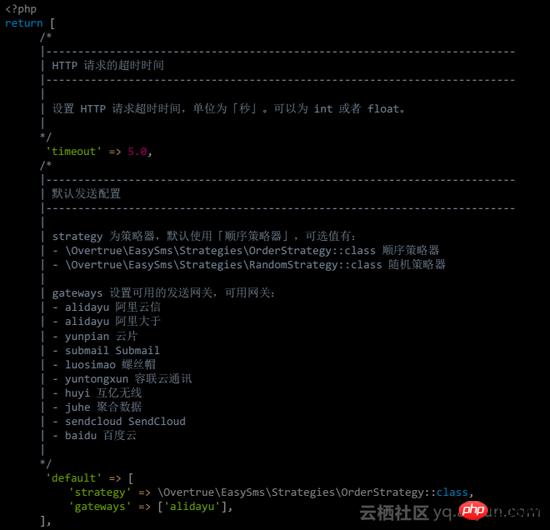

We have added a channel configuration for different scenarios, such as verification code scenario code to facilitate the messager to read the configuration.
Then open AppServiceProvider.php and add the following in register:

So far, the integration of EasySms in Laravel has been completed, but the actual function has not been developed yet. We Then look down.
Develop sms sending channel
Why develop? First of all, easy-sms supports a lot. You can consider developing a notification sending channel class for each sending platform separately, or you can develop only one SMS sending channel class. We choose to develop an SMS notification sending class through the easy-sms strategy. Mechanism to send verification codes to multiple platforms.
First, create a new app/Notifications/Channels/SmsChannel.php file. Because Laravel does not provide a generation function, you need to create this yourself. Just implement the send method. The content of SmsChannel is as follows:
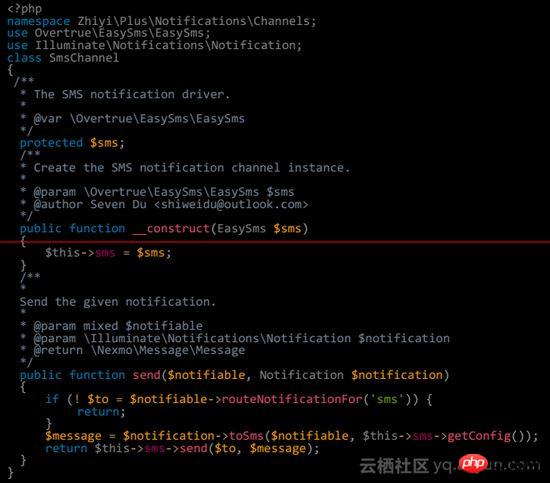
The SMS notification sending channel based on easy-sms has been completed.
Development scenario to send messages
This part belongs entirely to easy-sms development. We create a new VerificationCodeMessage.php with the following content:
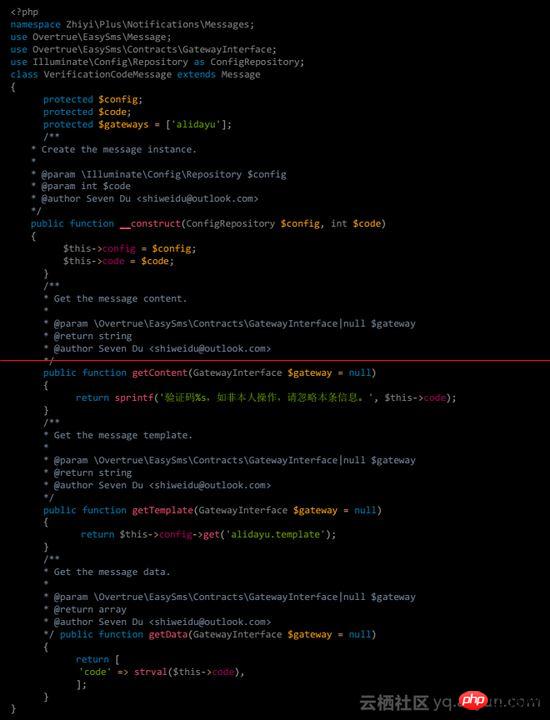
Then we return to the VerificationCode verification code notification class and add the toSms method. My code is as follows:

Scenario configuration , such as templates for different channels of verification codes, etc., so that the message server can determine the configuration of the usage scenario based on the sending gateway.
Complain again, the contract design of easy-sms should also have this idea, but getContent/getTemplate/getData does not pass the gateway at all when the actual gateway is called. . .
Okay, our development is completed.
Send verification code
It has been added to the "factory" when creating the verification code data model, so we can use the factory directly The function is complete, send the demo:
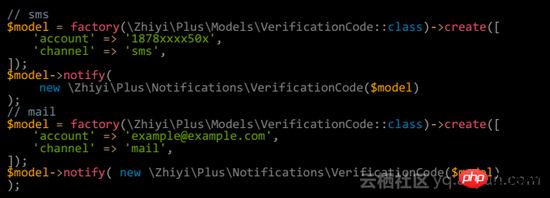
#You’re done, easy-sms is a very good package.
The above codes are all from ThinkSNS Plus
The above is the entire content of this article. I hope it will be helpful to everyone's learning. For more related content, please pay attention to the PHP Chinese website!
Related recommendations:
User registration and login through Laravel
Learning to transfer array to view in Laravel5 framework
The above is the detailed content of Develop SMS verification code sending function through Laravel 'standard'. For more information, please follow other related articles on the PHP Chinese website!




